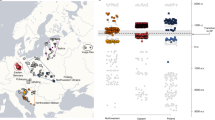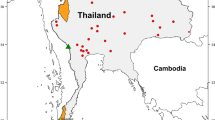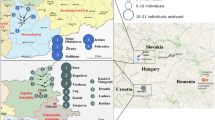Abstract
Homogeneous Proto-Slavic genetic substrate and/or extensive mixing after World War II were suggested to explain homogeneity of contemporary Polish paternal lineages. Alternatively, Polish local populations might have displayed pre-war genetic heterogeneity owing to genetic drift and/or gene flow with neighbouring populations. Although sharp genetic discontinuity along the political border between Poland and Germany indisputably results from war-mediated resettlements and homogenisation, it remained unknown whether Y-chromosomal diversity in ethnically/linguistically defined populations was clinal or discontinuous before the war. In order to answer these questions and elucidate early Slavic migrations, 1156 individuals from several Slavic and German populations were analysed, including Polish pre-war regional populations and an autochthonous Slavic population from Germany. Y chromosomes were assigned to 39 haplogroups and genotyped for 19 STRs. Genetic distances revealed similar degree of differentiation of Slavic-speaking pre-war populations from German populations irrespective of duration and intensity of contacts with German speakers. Admixture estimates showed minor Slavic paternal ancestry (∼20%) in modern eastern Germans and hardly detectable German paternal ancestry in Slavs neighbouring German populations for centuries. BATWING analysis of isolated Slavic populations revealed that their divergence was preceded by rapid demographic growth, undermining theory that Slavic expansion was primarily linguistic rather than population spread. Polish pre-war regional populations showed within-group heterogeneity and lower STR variation within R-M17 subclades compared with modern populations, which might have been homogenised by war resettlements. Our results suggest that genetic studies on early human history in the Vistula and Oder basins should rely on reconstructed pre-war rather than modern populations.
Similar content being viewed by others
Log in or create a free account to read this content
Gain free access to this article, as well as selected content from this journal and more on nature.com
or
References
Rosser ZH, Zerjal T, Hurles ME et al: Y-chromosomal diversity in Europe is clinal and influenced primarily by geography, rather than by language. Am J Hum Genet 2000; 67: 1526–1543.
Ploski R, Wozniak M, Pawlowski R et al: Homogeneity and distinctiveness of Polish paternal lineages revealed by Y chromosome microsatellite haplotype analysis. Hum Genet 2002; 110: 592–600.
Kayser M, Lao O, Anslinger K et al: Significant genetic differentiation between Poland and Germany follows present-day political borders, as revealed by Y-chromosome analysis. Hum Genet 2005; 117: 428–443.
Schenker AM : The Dawn of Slavic: An Introduction to Slavic Philology. New Haven: Yale University Press, 1995.
Norberg M : Die Sorben: slawisches Volk im Osten Deutschlands; in Hinderling R, Eichinger LM, (eds):: Handbuch der mitteleuropäischen Sprachminderheiten. Tübingen: Gunter Narr, 1996.
Główny Urząd Statystyczny: Raport z wyników Narodowego Spisu Powszechnego Ludności i Mieszkań 2002. Warszawa: GUS, 2003.
Latoszek M (ed):: Kaszubi: monografia socjologiczna. Rzeszów: Towarzystwo Naukowe Organizacji i Kierownictwa, 1990.
Zaroff R : Germanisation of the land between the Elbe-Saale and the Oder rivers: colonisation or assimilation? Proc Univ Qld Hist Res Group 1998; 9: 1–19.
Karaś H (ed): Dialekty i gwary polskie: kompendium internetowe. Zakład Historii Języka Polskiego i Dialektologii Uniwersytetu Warszawskiego & Towarzystwo Kultury Języka, 2010, http://www.dialektologia.uw.edu.pl/.
Curta F : From Kossina to Bromley: ethnogenesis in Slavic archaeology; in Gillett A, (ed):: On Barbarian Identity: Critical Approaches to Ethnicity in the Early Middle Ages. Turnhout: Brepols, 2002, pp 201–218.
Rębała K, Mikulich AI, Tsybovsky IS et al: Y-STR variation among Slavs: evidence for the Slavic homeland in the middle Dnieper basin. J Hum Genet 2007; 52: 406–414.
Nichols J : The linguistic geography of the Slavic expansion; in Maguire RA, Timberlake A, (eds): American Contributions to the Eleventh International Congress of Slavists. Columbus: Slavica Publishers, 1993, pp 377–391.
Martínez-Cruz B, Harmant C, Platt DE et al: Evidence of pre-Roman tribal genetic structure in Basques from uniparentally inherited markers. Mol Biol Evol 2012; 29: 2211–2222.
Martínez-Cruz B, Ziegle J, Sanz P et al: Multiplex single-nucleotide polymorphism typing of the human Y chromosome using TaqMan probes. Investig Genet 2011; 2: 13.
Excoffier L, Laval G, Schneider S : Arlequin (version 3.0): an integrated software package for population genetics data analysis. Evol Bioinform Online 2005; 1: 47–50.
Woźniak M, Grzybowski T, Starzyński J, Marciniak T : Continuity of Y chromosome haplotypes in the population of Southern Poland before and after the Second World War. Forensic Sci Int Genet 2007; 1: 134–140.
Roewer L, Croucher PJP, Willuweit S et al: Signature of recent historical events in the European Y-chromosomal STR haplotype distribution. Hum Genet 2005; 116: 279–291.
Woźniak M, Malyarchuk B, Derenko M et al: Similarities and distinctions in Y chromosome gene pool of Western Slavs. Am J Phys Anthropol 2010; 142: 540–548.
Slatkin M : A measure of population subdivision based on microsatellite allele frequencies. Genetics 1995; 139: 457–462.
Bandelt H-J, Forster P, Röhl A : Median-joining networks for inferring intraspecific phylogenies. Mol Biol Evol 1999; 16: 37–48.
Polzin T, Daneshmand SV : On Steiner trees and minimum spanning trees in hypergraphs. Oper Res Lett 2003; 31: 12–20.
Hurles ME, Nicholson J, Bosch E, Renfrew C, Sykes BC, Jobling MA : Y-chromosomal evidence for the origins of Oceanic-speaking peoples. Genetics 2002; 160: 289–303.
Kayser M, Krawczak M, Excoffier L et al: An extensive analysis of Y-chromosomal microsatellite haplotypes in globally dispersed human populations. Am J Hum Genet 2001; 68: 990–1018.
Sengupta S, Zhivotovsky LA, King R et al: Polarity and temporality of high-resolution Y-chromosome distributions in India identify both indigenous and exogenous expansions and reveal minor genetic influence of Central Asian pastoralists. Am J Hum Genet 2006; 78: 202–221.
Kreja B : Księga nazwisk ziemi gdańskiej. Gdańsk: Wydawnictwo Uniwersytetu Gdańskiego, 1998.
Rymut K : Nazwiska Polaków: słownik historyczno-etymologiczny. Kraków: Wydawnictwo Instytutu Języka Polskiego PAN, 1999–2001.
Breza E : Nazwiska Pomorzan: pochodzenie i zmiany. Gdańsk: Wydawnictwo Uniwersytetu Gdańskiego, 2000–2004.
Wilson IJ, Weale ME, Balding DJ : Inferences from DNA data: population histories, evolutionary processes and forensic match probabilities. J R Stat Soc Ser A Stat Soc 2003; 166: 155–201.
Balaresque P, Bowden GR, Adams SM et al: A predominantly Neolithic origin for European paternal lineages. PLoS Biol 2010; 8: e1000285.
Willuweit S, Roewer L : Y chromosome haplotype reference database (YHRD): update. Forensic Sci Int Genet 2007; 1: 83–87.
Park SW, Hwang CH, Cho EM, Park JH, Choi BO, Chung KW : Development of a Y-STR 12-plex PCR system and haplotype analysis in a Korean population. J Genet 2009; 88: 353–358.
Weale ME, Weiss DA, Jager RF, Bradman N, Thomas MG : Y chromosome evidence for Anglo-Saxon mass migration. Mol Biol Evol 2002; 19: 1008–1021.
Plummer M, Best N, Cowles K, Vines K : CODA: convergence diagnosis and output analysis for MCMC. R News 2006; 6: 7–11.
R Development Core Team: R: A Language and Environment for Statistical Computing. Vienna: R Foundation for Statistical Computing, 2011.
Fenner JN : Cross-cultural estimation of the human generation interval for use in genetics-based population divergence studies. Am J Phys Anthropol 2005; 128: 415–423.
Dupanloup I, Bertorelle G : Inferring admixture proportions from molecular data: extension to any number of parental populations. Mol Biol Evol 2001; 18: 672–675.
Wang J : Maximum-likelihood estimation of admixture proportions from genetic data. Genetics 2003; 164: 747–765.
Helgason A, Sigurðardóttir S, Nicholson J et al: Estimating Scandinavian and Gaelic ancestry in the male settlers of Iceland. Am J Hum Genet 2000; 67: 697–717.
Underhill PA, Shen P, Lin AA et al: Y chromosome sequence variation and the history of human populations. Nat Genet 2000; 26: 358–361.
Underhill PA, Myres NM, Rootsi S et al: Separating the post-Glacial coancestry of European and Asian Y chromosomes within haplogroup R1a. Eur J Hum Genet 2010; 18: 479–484.
Myres NM, Rootsi S, Lin AA et al: A major Y-chromosome haplogroup R1b Holocene era founder effect in Central and Western Europe. Eur J Hum Genet 2011; 19: 95–101.
Główny Urząd Statystyczny: Narodowy Spis Powszechny z dnia 3 grudnia 1950 r.: miejsce zamieszkania ludności w sierpniu 1939 r. Warszawa: GUS, 1955.
Veeramah KR, Tönjes A, Kovacs P et al: Genetic variation in the Sorbs of eastern Germany in the context of broader European genetic diversity. Eur J Hum Genet 2011; 19: 995–1001.
Immel U-D, Krawczak M, Udolph J et al: Y-chromosomal STR haplotype analysis reveals surname-associated strata in the East-German population. Eur J Hum Genet 2006; 14: 577–582.
Balaresque P, Bowden GR, Parkin EJ et al: Dynamic nature of the proximal AZFc region of the human Y chromosome: multiple independent deletion and duplication events revealed by microsatellite analysis. Hum Mutat 2008; 29: 1171–1180.
Acknowledgements
We thank all the donors, who have voluntarily donated their biological samples for the study, Professor Thomas Meitinger (Institute of Human Genetics, Neuherberg) for sharing samples, Professor Manfred Kayser (Erasmus University Medical Centre, Rotterdam) for Y-chromosomal lineage data from German regional populations, and Isabel Mendizabal (Institut de Biologia Evolutiva, CSIC-UPF) and Dr David F Soria-Hernanz (National Geographic Society) for an R script implemented in analysis of BATWING output files. BATWING and R calculations were carried out at the Academic Computer Centre in Gdańsk and on a computer cluster at the IBE, CSIC-UPF in Barcelona. KR was supported by the Foundation for Polish Science within the KOLUMB Programme and by the ‘Crescendum Est – Polonia’ Foundation. BM-C and DC were supported by MCINN grant CGL2010-14944/BOS.
Author information
Authors and Affiliations
Consortia
Corresponding author
Ethics declarations
Competing interests
The authors declare no conflict of interest.
Additional information
Supplementary Information accompanies the paper on European Journal of Human Genetics website
Appendix
Appendix
The Genographic Consortium
Syama Adhikarla1, Christina J Adler2, Elena Balanovska3, Oleg Balanovsky3, Jaume Bertranpetit4, Andrew C Clarke5, Alan Cooper2, Clio SI Der Sarkissian2, Matthew C Dulik6, Jill B Gaieski6, ArunKumar GaneshPrasad1, Wolfgang Haak2, Marc Haber4,7, Angela Hobbs8, Asif Javed9, Li Jin10, Matthew E Kaplan11, Shilin Li10, Elizabeth A Matisoo-Smith5, Marta Melé4, Nirav C Merchant11, R John Mitchell12, Amanda C Owings6, Laxmi Parida9, Ramasamy Pitchappan1, Daniel E Platt9, Colin Renfrew13, Daniela R Lacerda14, Ajay K Royyuru9, Fabrício R Santos14, Theodore G Schurr6, Himla Soodyall8, David F Soria Hernanz15, Pandikumar Swamikrishnan16, Chris Tyler-Smith17, Arun Varatharajan Santhakumari1, Pedro Paulo Vieira18, Miguel G Vilar6, R Spencer Wells15, Pierre A Zalloua7, Janet S Ziegle19
Affiliations for participants: 1Madurai Kamaraj University, Madurai, Tamil Nadu, India; 2University of Adelaide, South Australia, Australia; 3Research Centre for Medical Genetics, Russian Academy of Medical Sciences, Moscow, Russia; 4Universitat Pompeu Fabra, Barcelona, Spain; 5University of Otago, Dunedin, New Zealand; 6University of Pennsylvania, Philadelphia, PA, USA; 7Lebanese American University, Chouran, Beirut, Lebanon; 8National Health Laboratory Service, Johannesburg, South Africa; 9IBM, Yorktown Heights, NY, USA; 10Fudan University, Shanghai, China; 11University of Arizona, Tucson, AZ, USA; 12La Trobe University, Melbourne, Victoria, Australia; 13University of Cambridge, Cambridge, UK; 14Universidade Federal de Minas Gerais, Belo Horizonte, Minas Gerais, Brazil; 15National Geographic Society, Washington, DC, USA; 16IBM, Somers, NY, USA; 17The Wellcome Trust Sanger Institute, Hinxton, UK; 18Universidade Federal do Rio de Janeiro, Rio de Janeiro, Brazil; 19Applied Biosystems, Foster City, CA, USA
Rights and permissions
About this article
Cite this article
Rębała, K., Martínez-Cruz, B., Tönjes, A. et al. Contemporary paternal genetic landscape of Polish and German populations: from early medieval Slavic expansion to post-World War II resettlements. Eur J Hum Genet 21, 415–422 (2013). https://doi.org/10.1038/ejhg.2012.190
Received:
Revised:
Accepted:
Published:
Issue date:
DOI: https://doi.org/10.1038/ejhg.2012.190
Keywords
This article is cited by
-
Genetic diversity in Kashubs: the regional increase in the frequency of several disease-causing variants
Journal of Applied Genetics (2022)
-
Phylogeographic review of Y chromosome haplogroups in Europe
International Journal of Legal Medicine (2021)
-
Genetic analysis of male Hungarian Conquerors: European and Asian paternal lineages of the conquering Hungarian tribes
Archaeological and Anthropological Sciences (2020)
-
Y-chromosomal connection between Hungarians and geographically distant populations of the Ural Mountain region and West Siberia
Scientific Reports (2019)
-
Mitochondrial DNA variability of the Polish population
European Journal of Human Genetics (2019)



